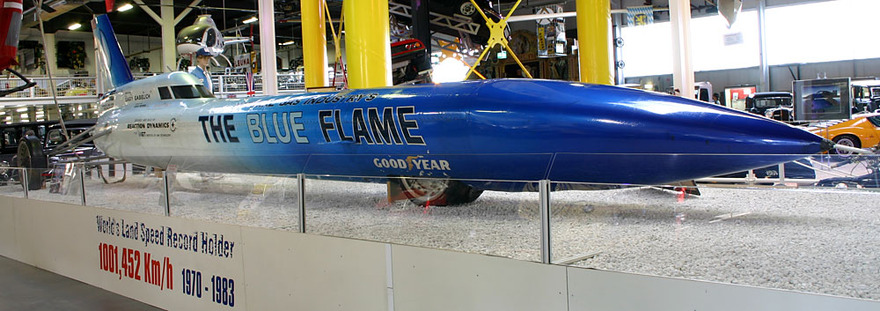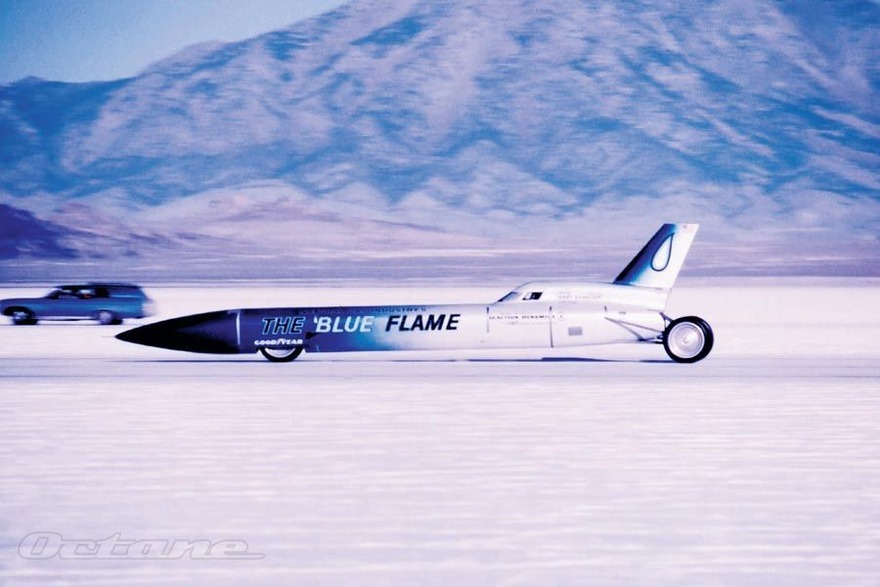60s of the XX century inspired people to be «faster, higher, stronger» with successful cosmic launches: satellites, first man in space, first spacewalk, flights to the Moon. All this achievements made the racers to dream on new records.
For example to achieve supersonic speeds on the ground. In this article we will show you a story of a brilliant project, which culminated in a new world speed record of more than 1000 km/h, the incredible man who was driving this car and how opportunities can be overtaken by marketing ideas.
In 1965 in Milwaukee, Wisconsin, USA, Dick Keller and Ray Dausman, two friends, founded Reaction Dynamics company. Later the company was joined by Pete Farnsworth a racer in Top Alcohol, American analogue Top Methanol, one of the professional drag racing classes.
Dick Keller graduated from the University of Notre Dame near Chicago and the University of Illinois and after that he started to research fine particles in the Illinois Institute of Technology, the research division of American Gas Association. He worked for US Air Force and NASA in terms of satellites and «Saturn» rockets. He also investigated chemical reaction of methane and oxygen as a source of rocket fuel. And of course, he was a successful racer.
Dick Keller was just married and as a wedding gift to his wife he refused to continue his drag racing career (this was her condition. Yeah, this is horrible!). But he did not give up and decided to try himself at another role. He had a dinner with Dausman, who at that time worked under NASA contract developing a rocket fuel; and they discussed plans of a rocket dragster. Considering various options, they came to conclusion that the best fuel for rocket dragster is hydrogen peroxide.
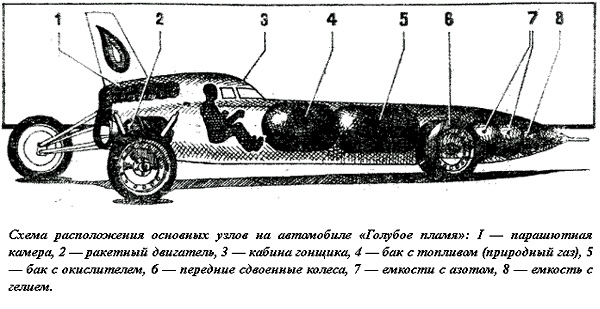
At that time, the engineers did not have powerful computers. All calculations were made with the slide rule and drawings. Around 70 students and professors, especially selected by Dick Keller for this project, worked on calculations which have been included in the curriculum of the Technological Institute of Illinois.
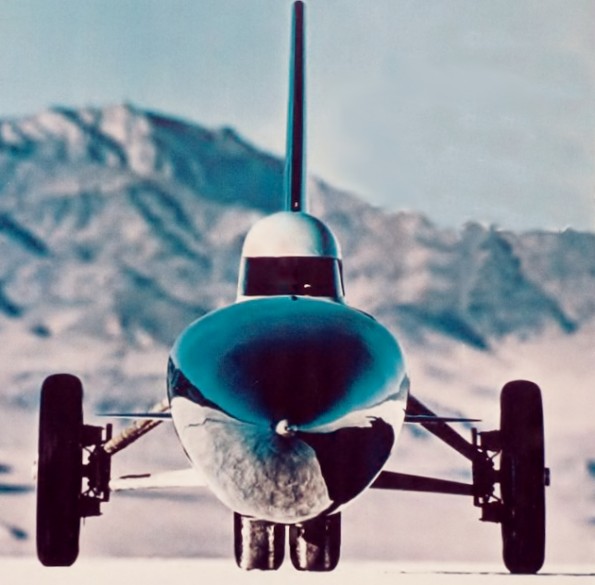
The body of the rocket dragster was made of aluminum, it was a semi-monocoque — a structure where the load is carried by both: an external thin shell and reinforcing its frame. The car got the “Blue Flame” name: its contour and color scheme remind the flame coming out of a gas burner. The car had a length of 11.39 meters and a height to the top of the tail 2.47 meters.
Four wheels, two of them are far behind and twin wheel in the nose, wore specially designed Goodyear slicks. These wheels had very low steering angle and the turning radius of the car was about 400 meters. After the record was set these tires became the fastest in the history of the automotive industry. Despite the fact that the actual tire tests were conducted at speeds of up to 1600 km/h, Goodyear Tyre Company limited the speed for the tires at a level of 700 mph (1126,5 km/h), so a two-stage injector has been changed to reduce the maximum thrust almost for almost two times. During the tests, the tires were used at 25 races with a maximum speed of 800 km/h and were named «the fastest tires in the world.»

During this period of his life, Gary lived with his parents in the vicinity of Long Beach, California, in the Bixby Knolls town. He worked as a driver for Vermillion's Drug Store and he drove Volkswagen Kombi — the legendary symbol of the sixties. Then he found himself in North American Aviation in Downey, California, in the postal service. After the merger with Rockwell-Standard in 1967 it transformed into a North American Rockwell.
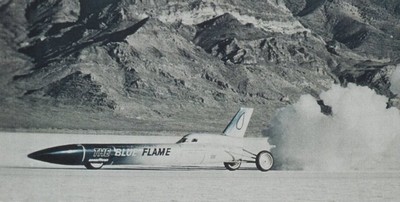
While working for Rockwell, Gabelich continued a drag pilot career. He became a celebrity in Southern California in 1963, when he won the first race of the United Drag Racing Association, he was the first in 1967 who approached closely to seven seconds, after passing the road for 7.05 seconds on his Double Fuel dragster. In 1969 he exceeded 200 miles per hour (322km/h) driving Beach City Chevrolet Corvette funny car, which was a first Chevrolet funny car.
Despite the fact that drag racing was popular among many employees of various aerospace companies, which were located in Southern California, Gary was called to the top-management of North American Rockwell and received an ultimatum: either he continues to participate drag racing or continues the project, so the company was afraid to lose a valuable employee, which was invested in a lot. The choice was obvious for Gary and he left the company to take another step to the title of «the fastest man on earth.»
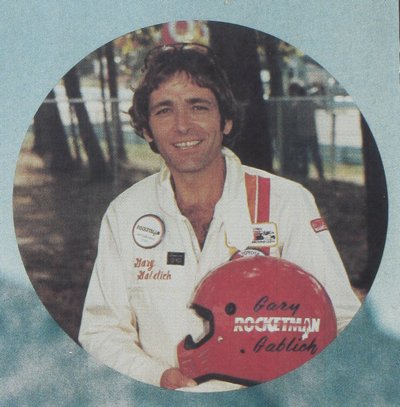
He had two accidents in Corvette Funny Car (Beach City Corvette). The first time he lost the parachute and finished on the highway in flames, and the second time the car caught fire during the pass and burned totally and Gary had to jump out at speeds exceeding 100 miles per hour. In this accident, his goggles and helmet were almost burnt, but the face and hands were practically without damages.
The most terrible accident happened in 1973, while driving a Funny Car in Orange County International Raceway. It was a four-wheel drive car that was built too quickly and was not very well thought through. While photographing for the magazine Gary occasionally blocked the throttle in «burn out» position and immediately forgot about it. At a speed of over 180 miles per hour he struck his car twice through the fence and turned over. In this accident, Gary nearly lost an arm, which remained hanging on the stripe of skin, one leg was cast behind the head, and the other wrapped around the steering column. Surgeons have “assembled” a hand and one leg, and the other one below the ankle was crammed with fragments of bone and should be amputated. But Gary did not let his leg amputated, and a long rod replacing the bone was put into it. Gary was able to adapt to a disability, but he treated gangrene for almost a year. According to Gary’s words, time in the hospital gave him the opportunity to think well things through and come back in good shape to continue the fight for the right to set a new speed record.
Gabelich achieved success in everything he only wished to undertake. After he became famous, he had to take a nickname Orval Volotch, to participate in motorcycle racing without pressure of his fame. He won the class of «Pilots without category», having passed his first racing in the desert.
«Maybe I would have to do something different. But I'm here now and I have to do my job properly, „- said Gary. And his enthusiasm infected the whole team. Sometimes happened that Gabelich played records of Isaac Hayes, which were intended to bring everyone in a great mood and bring positive vibrations to the things that they were going to do — so much he influenced others and used it for the benefit.
How did Gary Gabelich become a pilot of the «Blue Flame»?
Initially, Craig Breedlove who was setting speed records in the early 60s driving jet dragsters in Bonneville (with aircraft jet engnes) had to become a driver. But as the champion, he requested too much for his service and this was impossible for Reaction Dynamics. Then the company began to work with the already known Chuck Suba, but he died soon on tests. The project team tried to engage Don Garlits, but Don’s family persuaded to this idea. Finally, American Gas Association has confirmed Gary Gabelich, former test-astronaut and adrenaline addict as a potential record driver. Thus, luck turned to Gabelich and he took advantage of this opportunity.

September 14, 1970 — a day in the next two-week «window» when tests were conducted on the surface of the Bonneville salt lake. During testing internal engines exploded but fortunately, the damage was not very serious only one stage of the fuel injector was broken and the team was able to begin testing at low power, using only hydrogen peroxide. Average speed fluctuated around 400 miles per hour, while the current speed record was about 600.
The car had to be brought to Salt Lake City to repair the fuel system. Time was lost, and the money was spent out. But the team returned to the Bonneville and continued to set up engines. Due to exceeding fuel consumption burning gas escaped beyond the body, cut fire parachute straps, and then, when Gary tried to activate a brake parachute, it was burned as well. However, the constructors achieved a steady speed of 600 miles per hour and set a date of record attempt — 23 October, 1970.
At this point, the budget from AGA was almost over. It was the 23rd race, the latest one and it turned out to be a record. «Blue Flame» showed absolute speed record in the 622 miles per hour in 1 mile and 630 miles per hour in 1 kilometer.
According to the plan, the car had to move with jet acceleration to mid-mile point, reached at this point, a top speed of 650 miles per hour (1,046 km/h), and then to move by inertion. Measuring points for the kilometer were placed inside the miles but were shifted closer to its end. As a result, the rate of the control kilometer was higher than the mile one by 8 miles per hour (12.8 km/h).
Let’s check it in the usual scale: in the first attempt at a distance of one mile was achieved the speed of 993.934 km/h, in the second — 1009.517 km/h, which was the time-averaged velocity of 1001.667 km / h. Actual record at a distance of 1 km was 1,014.294 km / h. For a world record FIA requires to drive control section in two directions with calculating the average result.
At the finish of friends pulled Harry out of the cab and began to swing it. Finally, the record of 600 miles per hour, set 5 years ago by Craig Breedlove on its turbojet Spirit of America — Sonic 1, was broken and the «sonic barrier» became nearer. Here next to the car and posing for photographers stood Gabelich. He said «I was given fuel enough for me just to a half of way, in the end of which I reached 1,050 kilometers per hour. If we were not afraid of tire destruction, I could overcome „the sonic barrier.“ Apparently the weather will not afford us to continue. But I'll definitely do it next time. »
However, everything went completely wrong. As soon as the car stopped, it started to rain. At night, the snow fell and it became clear that it really was the last opportunity to conduct check-in on the day of the salt lake. And then marketers of American Gas Association decided that the advertising campaign was successful and now you can earn money, showing the «Blue Flame» around the world. After the official registration of the record all the «extras» (pipes, fuel tanks and other components) were removed to reduce the weight of the car. And then the «Blue Flame» has gone to a two-year promotional tour around the world, bringing the American Gas Association, millions of dollars. Of course, after that it was impossible to return the car to the salt lake, because in case of an accident the company's image would be greatly affected. Therefore, the «Blue Flame» was sold to a Dutch private museum.
Gary tried to make contact with the new owner, but he found out that the car was dropped during unloading and received some damage, and lost interest in him. Now the legendary «Blue Flame» is in the Museum of Technology in Sinsheim (Auto- und Technikmuseum Sinsheim), Germany. All the exterior of the car and its frame remained intact and preserved to this day.
It was a personal tragedy for Gary Gabelich who knew exactly that he was able to establish next record speed and break the sonic barrier on this car. But the sonic speed will be reached by another pilot and another car 27 years later, and the absolute speed record, set in 1970, will be surpassed only in 1983 it.
Gary Gabelich will try to build his own rocket dragster called the American Way. The basic idea was to pass the shock wave under the vehicle at an angle of 45 degrees, hitting the ground and then bounce off the machine, rather than turn it over. He suggested to the Institute for gas processing to sponsor a new record dragster, but after long negotiations the Institute denied.
Breedlove will invest his 300 thousand dollars earned in the races, in the construction of a Spirit of America — Sonic 2 turbojet, but this is a completely different story. Until that time, newspapers supported the public interest in the speed record, throwing articles about the development of new vehicles, a «show of the incredible speed — a duel between Craig Breedlove and Gary Gabelich», but there was no word of truth at all.
This speed record was the last on the Lake Bonneville. Subsequent records were set in the Black Rock Desert, Nevada, and these cars were not driven by Americans. In 1984 Gary Gabelich dies after a motorcycle accident, crashing into the right side of the truck at a high speed. After 44 years of his life, Gary Gabelich left warmest memories in hearts of his friends, acquaintances and fans. It was a very brave man, ready to work as much as possible to achieve the goal.
Newspapers around the world wrote about new speed record set by Gary. Looking through European newspapers, Dick Keller saw the headline in the German magazine «Stern»: «More than 1000 km/h for the first time.» In the United States with its imperial measuring units and focusing only on the miles per hour, nobody decided to translate the results into kilometers per hour and see the beautiful figure. «Well, that's interesting» — thought Dick. And now we all know the «Blue flame» and the team that worked on this project as the first high-speed vehicle which overcame the mark of 1,000 km / h.
Driver Gary Gabelich (USA)
Car The Blue Flame (USA)
Date 23rd October 1970
Speed 630.388 mph (k)
Place Bonneville Flats, USA.
Power Source Reaction Dynamics pressure fed bio-repellant rocket system
Max power 35,000 hp
Max Thrust 5,897kg. (13,000 lbs)
Construction aluminium body
Length 11.394 m (37'4.6”)
Width 2,34 m (7’8”).
Height to top of tail fin 2.47m (8'1.5”).
Wheelbase 7.77m (306”)
Ground clearance 241mm (9.5”)
Weight (approx.) 4,000 pounds (1,800 kilograms)
6,600 pounds (3,000 kilograms) fully fueled and loaded
Information from:
E. Kochnev Peoples. Cars. Records.
thevelvetrocket.com/2009/06/27/gary-gabelich/
www.classicandperformancecar.com

